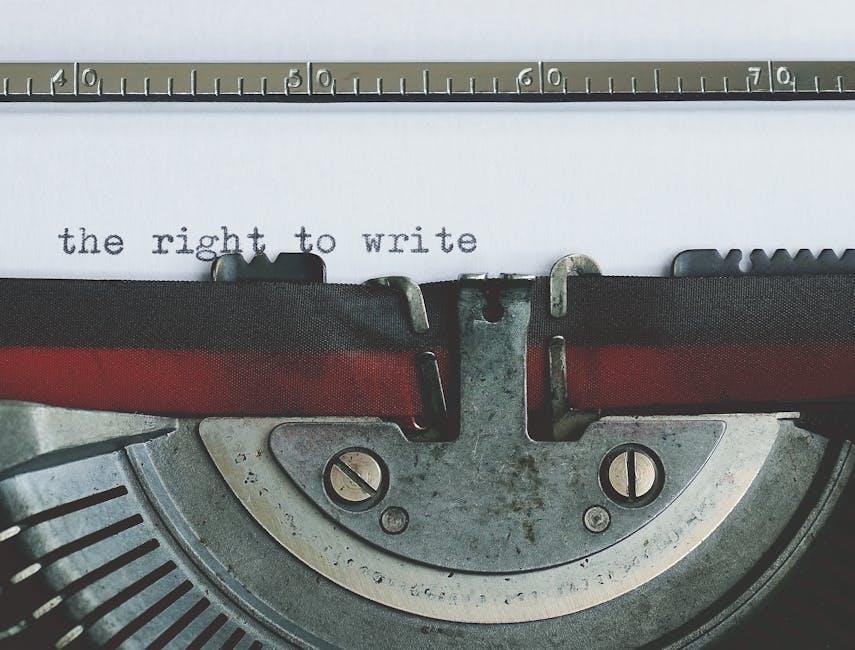
manual de convivencia
Manual de Convivencia: A Comprehensive Guide

A Manual de Convivencia is a crucial document in educational institutions. It outlines the norms and behavioral guidelines for the entire school community. This includes students, teachers, administrators, and parents. This guide promotes a secure, respectful, and harmonious environment for everyone involved, according to online resources.
What is a Manual de Convivencia?
A Manual de Convivencia is essentially a rulebook for a school or educational institution. It’s a document that compiles all the norms, regulations, and agreements regarding coexistence within the educational community. Think of it as a guide that sets clear limits, norms, and expectations for everyone involved, from students and teachers to administrative staff and parents.
This manual outlines the rights and responsibilities of each member. It details expected behaviors, disciplinary procedures, and conflict-resolution strategies. Its purpose is to create a safe, respectful, and orderly learning environment where everyone can thrive. The manual ensures that all members of the community understand how to interact positively and productively.

Furthermore, the Manual de Convivencia is more than just a list of rules. It is a tool for promoting understanding, respect, and responsibility among all stakeholders. It acts as a reference point for navigating various situations that may arise in the school setting. It also supports the development of students’ social and emotional skills, preparing them to be responsible and engaged citizens.
Purpose of a Manual de Convivencia
The primary purpose of a Manual de Convivencia is to foster a positive and harmonious environment within an educational institution. It serves as a guiding document. It promotes respect, responsibility, and understanding among all members of the school community. This includes students, teachers, administrators, and parents. It aims to create a safe and supportive space where everyone can learn and grow.
Furthermore, the manual seeks to prevent conflicts and provide clear procedures for resolving them when they arise. By outlining expected behaviors and consequences for violations, it sets clear boundaries and ensures accountability. It also establishes a framework for promoting values such as empathy, tolerance, and peaceful coexistence. The manual empowers students to become responsible and engaged citizens, contributing to a more just and equitable society.
In essence, the Manual de Convivencia is a tool for building a strong and cohesive school community. It ensures everyone understands their rights and responsibilities. It promotes a culture of respect, collaboration, and mutual support. Through its effective implementation, the manual contributes to the overall well-being and success of the students and the entire educational institution.
Key Components of a Manual de Convivencia
A Manual de Convivencia typically encompasses several key components. These components are essential for establishing a comprehensive framework for promoting positive coexistence within the educational community. One crucial element is a clear statement of the institution’s values and principles; This includes respect, responsibility, honesty, and fairness. These values serve as the foundation for all behavioral expectations outlined in the manual.
Another vital component is a detailed description of the rights and responsibilities of all members of the school community. This includes students, teachers, administrators, and parents. This ensures everyone understands their entitlements and obligations within the educational setting. The manual also includes specific rules and regulations regarding student conduct, dress code, attendance, and academic integrity. These rules help maintain order and ensure a conducive learning environment.
Additionally, the Manual de Convivencia outlines the procedures for addressing disciplinary issues. It also contains conflict resolution, and grievance mechanisms. These processes ensure fairness and due process for all parties involved. Finally, the manual includes information on support services available to students, such as counseling and academic assistance. This promotes their well-being and academic success.
Rights and Responsibilities within the Manual
The Manual de Convivencia clearly defines the rights and responsibilities of every member within the educational community. This encompasses students, teachers, administrative staff, and parents. This delineation is crucial for fostering a fair and respectful environment where everyone understands their roles. Students have the right to receive a quality education in a safe and supportive learning environment. They also have the right to express their opinions respectfully and to participate in school activities.
However, with these rights come responsibilities. Students are responsible for attending classes regularly, completing assignments diligently, and respecting the rights of others. They must adhere to the school’s rules and regulations and refrain from any behavior that disrupts the learning environment or endangers the well-being of others.
Teachers, on the other hand, have the right to academic freedom and to create a positive and engaging learning environment for their students. They are responsible for providing quality instruction, assessing student learning fairly, and maintaining discipline in the classroom. They must also communicate effectively with parents and collaborate with colleagues to support student success. Parents have the right to be informed about their child’s academic progress and to participate in school activities. They are responsible for ensuring their child attends school regularly, completes assignments, and adheres to the school’s rules. They must also communicate with teachers and school staff to support their child’s learning and well-being.
The Role of the Educational Community in Creating the Manual
The creation of a Manual de Convivencia is not a solitary endeavor; it’s a collaborative process that actively involves the entire educational community. This includes students, teachers, administrators, staff, and parents. Each stakeholder brings a unique perspective and understanding of the school environment, ensuring the manual reflects the needs and values of everyone.
Students provide insights into their experiences, concerns, and expectations for a positive learning atmosphere; Teachers contribute their expertise in classroom management, student behavior, and effective disciplinary practices. Administrators offer their knowledge of school policies, legal requirements, and resource allocation. Staff members share their observations of student interactions, school climate, and overall well-being. Parents provide valuable perspectives on their children’s needs, family values, and community expectations.
By involving all stakeholders in the creation process, the Manual de Convivencia becomes a shared document that everyone understands, supports, and feels ownership of. This fosters a sense of collective responsibility for maintaining a positive and respectful school environment where all members can thrive. The collaborative approach also ensures the manual is relevant, practical, and adaptable to the evolving needs of the educational community.
Implementation and Enforcement of the Manual
The creation of a Manual de Convivencia is only the first step; effective implementation and consistent enforcement are crucial for its success. The manual should be readily accessible to all members of the educational community. Distribution can be done through printed copies, online platforms, and presentations.
Teachers play a vital role in integrating the manual’s principles into their daily classroom practices. This includes modeling respectful behavior, facilitating discussions about the manual’s content, and consistently applying its guidelines. Administrators are responsible for ensuring the manual is consistently enforced across the school. They should also provide training and support to teachers and staff.

Consistent enforcement is key to maintaining the manual’s credibility and effectiveness. Consequences for violations should be fair, proportionate, and consistently applied. This requires clear procedures for reporting incidents, investigating violations, and implementing disciplinary actions. Regular monitoring and evaluation of the manual’s impact are essential. This helps identify areas for improvement and ensure it remains relevant and effective in promoting a positive school climate.
Benefits for Students and Families
A well-structured and effectively implemented Manual de Convivencia offers numerous benefits for both students and their families. For students, the manual provides a clear understanding of expected behaviors. This creates a more predictable and secure learning environment. When students understand expectations, they feel safer and more respected.
The manual also promotes the development of essential social and emotional skills. By outlining acceptable and unacceptable behaviors, it teaches students about respect, responsibility, and conflict resolution. These skills are crucial for success in school and in life. Families benefit from the manual by gaining a better understanding of the school’s expectations and disciplinary procedures.
This increased transparency fosters trust and strengthens the home-school partnership. Parents can use the manual as a guide for reinforcing positive behaviors at home. Ultimately, the Manual de Convivencia contributes to a more supportive and collaborative learning environment. Students and families feel empowered and respected, leading to improved academic outcomes and a stronger sense of community.
Conflict Resolution Processes Defined in the Manual
The Manual de Convivencia plays a vital role in outlining clear and structured conflict resolution processes within the educational community. A key aspect of the manual is its ability to proactively address conflicts. This is done by establishing a framework for resolving disputes fairly and effectively. These processes aim to foster a culture of understanding and empathy.
The manual outlines the steps to take when conflicts arise, ensuring a consistent and equitable approach for all parties involved. Often, the manual includes methods such as mediation, counseling, and restorative justice. It emphasizes open communication and active listening. These methods help students develop skills for resolving disagreements peacefully and constructively.
The Manual de Convivencia also defines the roles and responsibilities of different members of the community in resolving conflicts. This includes teachers, administrators, and parents. By providing a clear roadmap for addressing conflicts, the manual helps to minimize disruptions and promotes a more harmonious learning environment. This equips students with valuable life skills and reinforces a commitment to peaceful coexistence.
The Manual as a Tool for Promoting Peace and Respect
The Manual de Convivencia serves as a powerful instrument in cultivating a culture of peace and respect within the educational environment. It actively promotes positive relationships among students, faculty, and staff. By establishing clear guidelines for respectful behavior, the manual sets the stage for a more harmonious and inclusive atmosphere throughout the institution.
The manual emphasizes the importance of empathy, tolerance, and understanding. It also fosters an environment where differences are celebrated and valued. It provides a framework for addressing issues such as bullying, discrimination, and harassment, thus creating a safe space for all members of the community. Furthermore, it encourages students to develop crucial social and emotional skills.
Through its established norms and regulations, the Manual de Convivencia reinforces the significance of treating others with dignity. It promotes a shared commitment to fostering a peaceful and respectful environment. It guides students and staff toward constructive interactions, promoting a collaborative and supportive school culture. This, in turn, contributes to a more positive and productive learning experience.
Legal Basis and Framework for the Manual de Convivencia
The Manual de Convivencia isn’t just a set of rules; it’s a document often grounded in a robust legal basis and framework. This foundation ensures that the manual aligns with national and local laws, educational regulations, and human rights principles. By adhering to these legal standards, the manual gains legitimacy and strengthens its authority within the educational community.
The legal framework typically includes constitutional rights, laws related to education, child protection policies, and anti-discrimination statutes. These provide a foundation for the rights and responsibilities outlined in the manual. They ensure that the manual is consistent with broader societal values. Also, they protect the rights of all members of the school community.

Furthermore, the legal basis often dictates the procedures for developing, implementing, and enforcing the manual. This includes requirements for community involvement, transparency, and due process. A clear legal foundation ensures fairness and accountability. It also minimizes the risk of legal challenges.
The Manual de Convivencia is not arbitrary; it is built upon a strong legal bedrock.
Importance of Regular Review and Updates
The Manual de Convivencia is not a static document; its effectiveness relies on regular review and updates. Educational environments evolve, societal norms shift, and new challenges emerge, making periodic revisions essential. An outdated manual can become irrelevant, ineffective, and even detrimental to the school’s climate.
Regular reviews allow the educational community to assess the manual’s impact, identify areas for improvement, and address emerging issues. This process should involve students, teachers, administrators, and parents. This ensures diverse perspectives are considered and the manual reflects the community’s needs;
Updates may be necessary to incorporate changes in legislation, educational policies, or best practices in conflict resolution and discipline. They may also address new forms of misconduct, such as cyberbullying or online harassment. By staying current, the manual remains a relevant and effective tool for promoting a positive and safe learning environment.
Furthermore, regular review demonstrates a commitment to continuous improvement. It signals that the school values feedback and is willing to adapt to meet the evolving needs of its community.